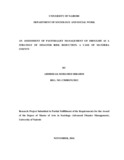| dc.description.abstract | Despite the numerous studies documented on the disaster risk management, the political, economic and social marginalization of most pastoralists, decades of adverse national policies which have restricted their access to key natural resources, increased frequency and intensity of climate shocks such as drought, and endemic conflict have all contributed to significantly undermine their resilience. It was in this light that the current study sought to carry out an assessment on pastoralist management of drought as a strategy of disaster risk reduction in Mandera County with a focus on Mandera East, Mandera West and Mandera South sub counties. The research was designed as a cross sectional descriptive study. The target respondents included pastoralists from Mandera East, Mandera West and Mandera South sub counties in Mandera County. According to the County Government (2014) 89.1% (91,292) of the families are dependent on pastoralism for their upkeep. For the purpose of this study, household heads in each of the three selected sub counties were involved. This generated a sample of 120. To avoid biasness, the households were picked proportionally in the North, South, East and West directions of each from each of the sub county. Data was collected using both quantitative and qualitative methods including questionnaire administration to the various stakeholders, key informant interview and Focused Group Discussions. Quantitative data was then entered into the Statistical Package for Social Sciences (SPSS). The frequencies and percentages were obtained. Tables and figures were used to present the data while descriptive statistics such as percentages and frequencies were used to answer research questions. The results of the analyzed quantitative data were presented by use of tables. Qualitative data collected from key informants were analyzed and presented as confirmation to the quantitative data collected from the community. The study also found that most of the areas in Mandera County are frequently struck by drought and water scarcity putting the pastoralists at a great drought disaster. The study deduces that the pastoralists are familiar with drought contingency planning. Drought relief strategy affects drought disaster risk reduction in Mandera. The pastoralists are knowledgeable about rehabilitation mechanism as a mitigation strategy. The study ascertained that rehabilitation mechanisms as a mitigation strategy is not carried at the right time of the drought cycle. The study recommends that government should put in place veterinary interventions measures that will enhance drought mitigation to prevent loss of animals during drought within the County. The community, planners, professionals and the implementers of drought disaster risk management need to realize and rise to the awakening that drought affected people have the learning and the strength to develop coping and survivability capacities. There is a need to enhance community communication and feedback mechanism in the county. The study also recommends that the government of Kenya and development agencies working in the area need to invest in the provision of credit facilities to the pastoralists to assist them in coping with droughts. The study recommends funds should be allocated for effective supplementary feeding programmes. | en_US |



